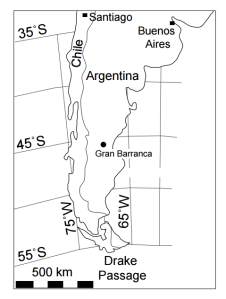Dunn, R.E., Schmitz, M.D., Madden, R.H., Kohn, M.J., Strömberg, C.A.E., Carlini, A.A., 2013. GSA Bulletin, v. 125, no. 3-4, p. 539-555. DOI: 10.1130/B30660.1 (Link)
To establish the temporal framework for vegetation reconstructions in Patagonia, I worked with Mark Schmitz and Jim Crowley at the Boise State University’s Isotope Geology Lab to develop a more refined and precise age model for the Sarmiento Formation at Gran Barranca.

Building on previous age models that used less precise 40Ar/39Ar dating and magnetostratigraphy, we dated nine volcanic tuffs using ID-TIMS U/Pb isotopic techniques using single zircon crystals. Ages for the samples ranged from 39.861–19.041 Ma and had error ranges of <1% in some cases. These dates are important because in combination with the existing magnetostratigraphy, they allow a more stable and precise age model from which to evaluate biotic change through time. Additionally, the new chronology helps refine the timing and duration of major hiatuses in deposition, and it provides the temporal constraints for six South American Land Mammal Ages (SALMAs), a broadly used scheme to date fossils across the continent.

Among the most important new findings is a new U/Pb date for the La Cancha Tuff of 33.581 ± 0.015 Ma. This precise date confirms that the Vera Member of the Sarmiento Formation records the Eocene-Oligocene Transition (EOT – 33.9 Ma) and Oi-1 glaciation events (33.7 Ma). These events are associated with full-scale Antarctic glaciation and the development of the Antarctic Circumpolar Current (ACC) which altered ocean heat transport and led to global cooling. The Vera Member at Gran Barranca represents the only terrestrial section in all of the Southern Hemisphere that preserves this interval of time. Additionally, the new age model allows for precise age determination of the numerous fossil phytolith levels from which the habitat reconstructions have been made. This precision is critical when linking climate events in the marine isotope record to the terrestrial record of plants and mammals at Gran Barranca.
